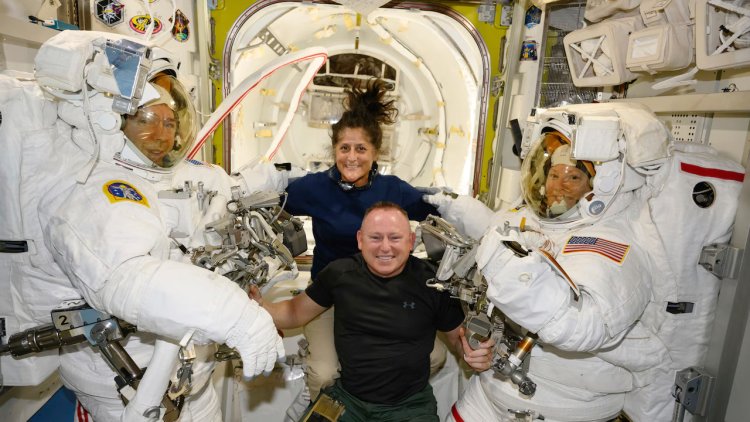Could NASA Astronauts Face an Extended Stay at the Space Station? Here's What You Should Know
NASA faces a crucial decision on whether to bring two astronauts back from the ISS using Boeing’s troubled Starliner or delay their return until next year with SpaceX. Discover the latest developments.

CAPE CANAVERAL, Fla. (AP) — NASA is currently evaluating the best course of action for returning two astronauts from the International Space Station (ISS) after their original return plan aboard Boeing’s Starliner capsule has faced multiple delays.
Options on the Table: Starliner vs. SpaceX
NASA must decide whether to take the risk of sending the astronauts home soon aboard Boeing's Starliner or to delay their return until next year using a SpaceX Dragon capsule. The astronauts, Butch Wilmore and Suni Williams, have been aboard the ISS since early June on what was initially an eight-day mission. However, they are now approaching two months in space, with the possibility of extending their stay to over eight months.
Testing on Boeing’s Starliner continues, with the company expressing confidence in the spacecraft. However, NASA remains divided, and a decision is expected soon.
Challenges with Boeing’s Starliner
This mission marks Boeing’s first attempt at launching astronauts after two previous uncrewed test flights faced software and other technical issues. Even before Wilmore and Williams launched on June 5, their capsule experienced a leak in propulsion-related plumbing. Although NASA and Boeing deemed the leak stable, four additional leaks occurred as the Starliner approached the ISS. Additionally, five thrusters malfunctioned, although four were eventually restored to working order.
Despite these setbacks, the capsule managed to dock safely with the ISS. However, the root cause of the thruster malfunctions remains unknown, raising concerns about crew safety during the critical deorbit burn required for re-entry.
Are the Astronauts Stuck?
NASA rejects the notion that Wilmore and Williams are "stranded" aboard the ISS. The agency has consistently emphasized that in the event of an emergency, such as a fire or decompression, the Starliner could still be used as a lifeboat. Former NASA executive Scott Hubbard noted that while the astronauts are "kind of stuck," they are certainly not stranded. They remain safe aboard the ISS, with ample supplies and work to keep them occupied.
Should NASA opt for a SpaceX return, the Starliner would first be undocked to free up one of the two U.S. capsule docking ports. Wilmore and Williams would then transfer to the SpaceX Dragon capsule currently docked at the station, which would serve as their lifeboat until a new Dragon capsule arrives to bring them home.
Why the Delay Until Next Year?
SpaceX’s Dragon capsule, like Boeing’s Starliner, is designed to carry four astronauts. To accommodate Wilmore and Williams, NASA might have to bump two astronauts from the crew set to launch next month, reserving their seats for Wilmore and Williams. This would mean an extended stay for the pair, possibly until February, as ISS missions typically last at least six months.
This situation is not unprecedented. NASA astronaut Frank Rubio and his Russian colleagues recently spent over a year in space after their Soyuz capsule was damaged by space debris, requiring an empty capsule to be sent up for their return.
How Are the Astronauts Coping?
Wilmore, 61, and Williams, 58, are both experienced astronauts with previous long-duration missions. Prior to the flight, they anticipated learning a great deal about the Starliner’s operations. During a July news conference from space, they assured the public that they were staying busy with repairs, research, and Starliner testing. They have not publicly commented on the possibility of an extended stay.
Are Supplies Sufficient?
Before the mission, the astronauts' personal belongings were removed from Starliner to make space for essential equipment for the ISS’s water recycling system. However, a supply ship recently arrived with their clothes, along with additional food and experiments for the nine-member crew. More supplies are scheduled to arrive in the coming months, and the ISS’s oxygen-generating systems are functioning normally. Nevertheless, NASA is eager to return to a regular schedule as soon as possible.
Why Is NASA Still Committed to Starliner?
NASA deliberately chose two companies—Boeing and SpaceX—to transport its crews to and from the ISS as a safeguard. This redundancy ensures that if one provider faces setbacks, the other can step in. Despite Starliner’s challenges, NASA remains committed to its partnership with Boeing, aiming to launch one Dragon and one Starliner each year until the ISS is retired in 2030.
Boeing’s Stance
Boeing maintains that its Starliner capsule is still capable of safely bringing the astronauts home. However, the company has stated that it will comply with NASA’s decision if an empty return is deemed necessary. Boeing has faced numerous delays and challenges with the Starliner program, costing the company over $1 billion. As testing continues, the priority remains to identify and resolve the issues to ensure the Starliner’s viability for future missions.







